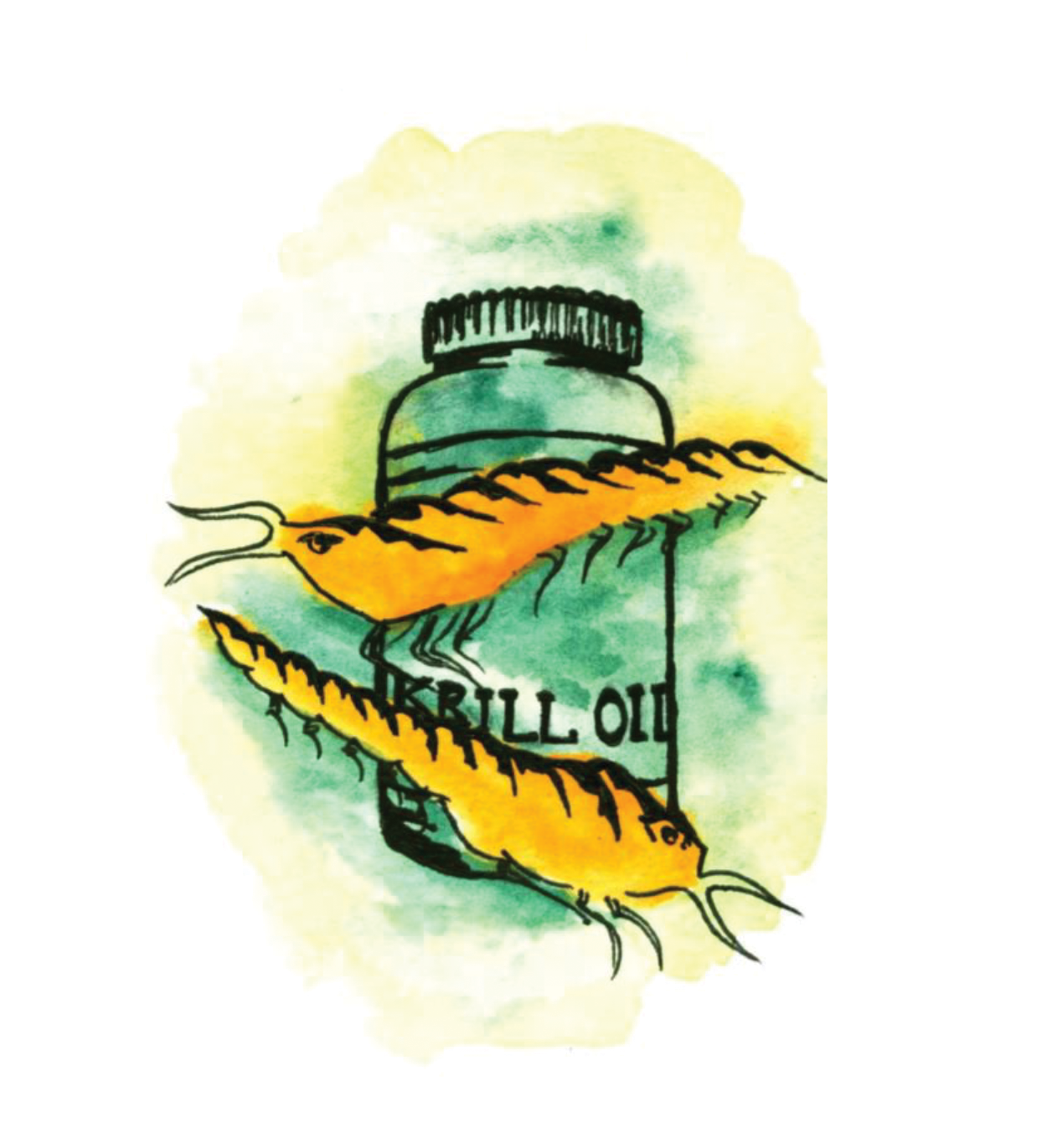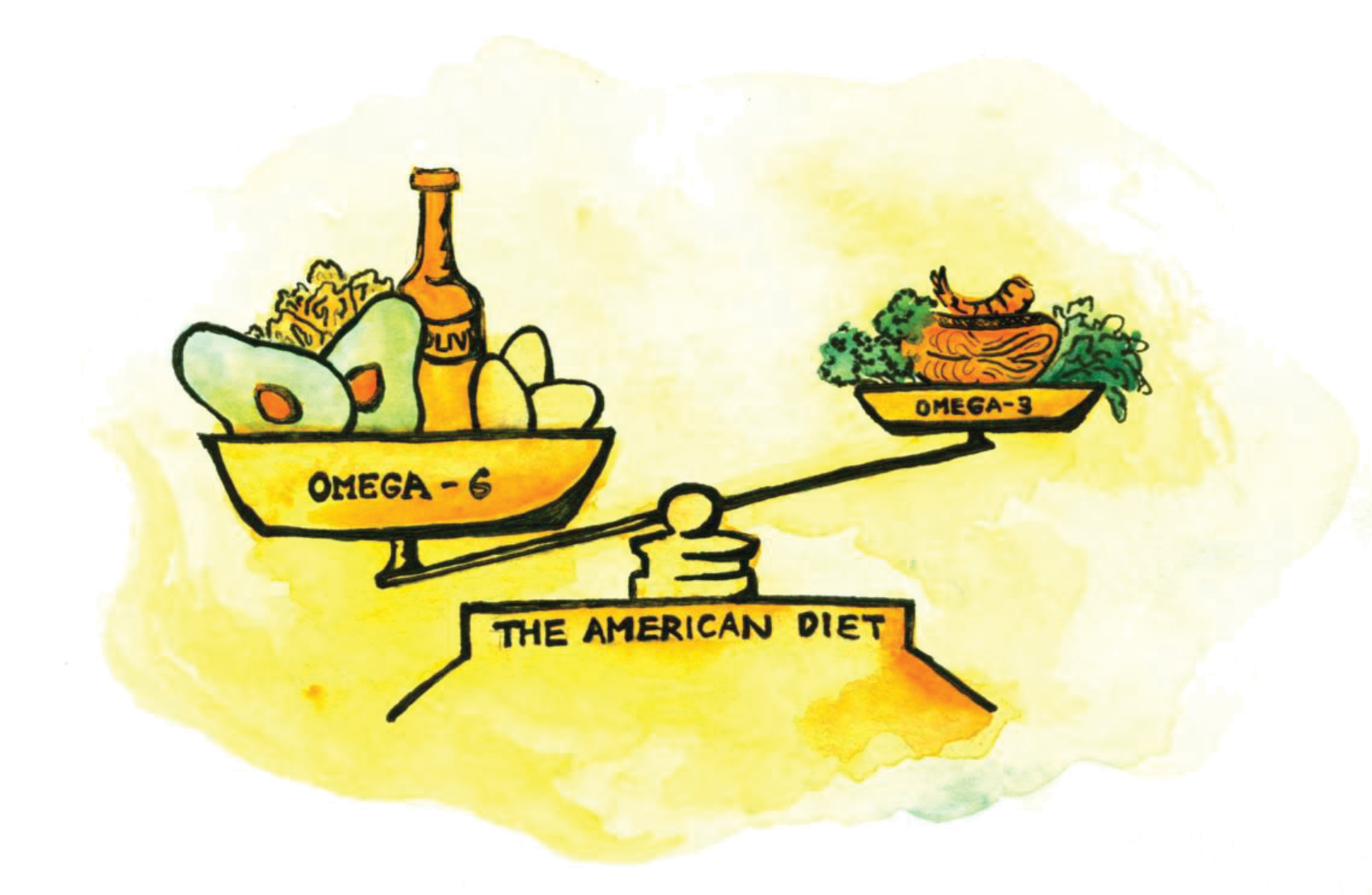There’s a problem in our society of which most people are blissfully unaware: we aren’t feeding our brains. One of the most important nutrients for proper brain development and function is significantly lacking in the Western diet. The Western diet is a nutritional pattern adopted by the United States and many other developed countries, and is currently spreading throughout the world [1]. In general, it is characterized by a significant intake of saturated fat, refined sugars, and simple carbohydrates in conjunction with reduced fruit and vegetable consumption [1].
From fetal development to the moment we die, we need omega-3 (n-3) polyunsaturated fatty acids for optimal cognition, memory, and psychological wellbeing, the last of which includes affect (our outward expression of emotion) [1]. Though much remains to be learned about the mechanisms through which n-3s function in our bodies, the plethora of benefits they provide is well supported by a growing body of research. Such research overturns a key misconception in our society: too often, people assume fats are inherently unhealthy and should be avoided, but this is simply untrue [2]. On the contrary, they can be health-promoting. Some are even essential. N-3s, for instance, are essential nutrients because they are necessary for our bodies to function optimally, but we cannot produce them ourselves, so they must be obtained through the diet [3].
There are three types of n-3s, two of which are considered essential [4]. These include eicosapentanoic acid (EPA) and docosahexaenoic acid (DHA), which are most commonly found in marine animals such as salmon, sardines, mackerel, and shellfish [4, 5]. The third type of n-3, alpha-linolenic acid (ALA), is found in plant sources such as walnuts, flax seeds, and leafy greens [6]. In the body, ALA can be converted into EPA and DHA, but the rate at which this happens is incredibly low [4]. For this reason, it is much more effective to consume EPA and DHA directly.
Throughout our evolutionary history, humans have consumed n-3s at about a 1:1 ratio with omega-6s (n-6s), another essential fatty acid that is commonly found in seeds and nuts [6]. However, in recent decades, estimates of the ratio of n-6 to n-3s in the body have been as high as 25:1 across those populations that have adopted the Western diet [7]. This is worth repeating: our population now consumes as much as twenty-five times more n-6s than n-3s. This is because sources of n-6s are prevalent in the Western diet, particularly in refined oils such as soybean oil, an ingredient in many processed foods. On the other hand, n-3s and the fatty fish in which they are abundant were left behind by the fast and processed food trends [7].
Both n-6s and n-3s are important for optimal health, but work in opposite ways; while n-6s promote inflammation, n-3s oppose inflammation [6]. Acute inflammation is a natural immune response in which white blood cells are called into action to help repair tissue damage or fight off foreign invaders [8]. The process is critical to combatting injury and infection. Chronic, systemic inflammation, on the other hand, can be incredibly detrimental to our health. It can be incited by autoimmune disorders, but can also result from smoking, lack of exercise, and processed, high-calorie diets [9]. So what do n-6s and n-3s have to do with this? We need acute inflammation, so we need n-6s [6]. However, we also need n-3s since they combat low-grade systemic inflammation. Both types of fatty acids are incorporated into cell membranes, so when the n-6 to n-3 ratio is balanced, n-3s can partially replace n-6s in cell membranes, producing anti-inflammatory effects. With the excess of n-6s and the inadequacy of n-3s in the Western diet, however, chronic inflammation becomes a serious problem [6]. This is correlated with increased cardiovascular disease, and current research proposes chronic inflammation likely plays a role in the development of some cancers [8]. As it pertains to the brain, there is evidence to support hypotheses that suggest inflammation is involved in depression and Alzheimer’s disease [10]. When a diet is balanced between n-6s and n-3s, the body can function optimally, but as this ratio is now significantly distorted in our population, we miss out on the potential for improved cognition, affect, and memory. In fact, the detriment of an n-3 deficient diet begins before we are even born [7].

Eating for Two
Though much of our nutrition and consequent health is in our own hands, one of the most important determinants of our health is in fact, entirely out of our control: it’s up to our mothers. In a study performed on mice by Sakayori et al., maternal excess of omega-6 and deficiency of omega-3 fatty acids during pregnancy was evidenced to cause notable impairment in the neocortical development of offspring [7]. The neocortex, the most recently evolved portion of the cerebral cortex in the mammalian brain, is involved in higher functioning, including conscious thought, language, and emotion. Sakayori et al. found the neocortex to be significantly thinner in an n-6 excess, n-3 deficient group than in the control group [7].
The findings in this study further suggest that impaired neocortical development, as a result of n-6/n-3 imbalance, may play a role in the pathophysiology of depression and anxiety disorders [7]. More specifically, the results propose a connection between decreased neocortical volume and development of these psychiatric conditions. In the study, the offspring of female mice who were fed the imbalanced diet exhibited abnormal, anxiety-related behavior when presented with an elevated maze test. This test is meant to measure anxiety by offering mice the option of spending time in enclosed or open arms of a plus-shaped maze. The mice become conflicted between their desire for protection in enclosed spaces and exploration of new, open environments. The mice displaying greater signs of anxiety spent more time in enclosed arms even after being fed a balanced fatty acid diet until they reached adulthood. This is an important finding suggesting that if n-3 inadequacy is established in the womb, it can create a lifelong detriment regardless of the nutritional choices made in the future [7].
Mood Boosters
The long-term effects of maternal n-3 deficiency, however, do not mean that change cannot be stimulated by an adequate n-3 diet after birth. For psychological wellbeing in particular, the value of n-3s extends far beyond embryonic and fetal development. N-3s are essential to psychological health, and their relative scarcity in the diet has been linked to mood disorders, particularly in recent decades [3].

A study published in 2014 by the Society of Biological Psychology evaluated both psychological and physiological differences in groups of adolescent rats after subjecting one group to an n-3 deficient diet and the other to an adequate diet [3]. The study opted to focus on adolescent rats, as adolescence is often the time period during which symptoms of psychopathological disorders initially appear. Of particular interest was the role of n-3 deficiency in perpetuating such disorders as anxiety, depression, schizophrenia, and ADHD [3].
In this experiment, researchers analyzed the behavior of two generations of rats with an inadequate n-3 diet, observing an increase in anxiety-related behavior between each generation [3]. This suggests that as the trend of n-3 inadequacy in our diet continues, its effects are amplified in our offspring [3].
Researchers paid particular attention to the second generation of rats, which was designed to represent the current generation of n-3-inadequate adolescents in our own society [3]. To further assess the effect of n-3 intake on adolescent mental status, researchers performed western blot analysis, which is a technique for protein identification. This was implemented to measure tyrosine hydroxylase (TH)—an enzyme involved in dopamine synthesis—in key areas known for dopamine transmission. Dopamine is a neurotransmitter involved in motivation and cognition. The dorsal striatum, a dopaminergic area involved in decision-making and learning, showed a significant elevation in TH levels, suggesting enhanced dopamine availability [3].
Differential dopamine availability, specifically in the dorsal striatum, is correlated with hyperactivity and increased risk for the development of schizophrenia later in life [3].
This study was designed to mimic current n-3 inadequacies in humans, so it is pertinent to consider how these findings may be applicable. The increased anxiety and altered dopamine availability prevalent in the subjects of the study warrants serious concern for the increasingly common n-3 inadequacy in the general population.
Human participant studies tend to confirm the benefits of n-3s on mood and affect. For instance, in a placebo-controlled human trial, Amminger et al. evaluated a group of adolescents and young adults (ages 13-25) deemed to be at ultra-high risk for developing a psychotic disorder [11]. After 12 weeks of n-3 or placebo consumption, followed by 40 weeks of monitoring, 27.5% of the placebo group had progressed to full threshold psychotic disorder, meaning they met all criteria for diagnosis. In the n-3 group, this figure was only 4.9% [11]. This discrepancy demonstrates the scope of possible consequences that can arise from n-3 inadequacy. Another important takeaway from this human trial is the consistency of its results with the results of the previous study, which relied on model organisms. In both cases, n-3s are linked to statistically significant changes in psychological wellbeing.
Think Long-term
As our bodies age, so do our brains, and eventually we face even more neurological risks, such as the development of Alzheimer’s disease. Konagai et al. studied the effects of n-3s in healthy Japanese male volunteers in their sixties and seventies [5]. The study enlisted two groups: one given a placebo for twelve weeks, and the other given krill or sardine oil. Researchers then evaluated cerebral cortex activation during memory and calculation tasks. Activation was significantly greater in the experimental group than in the control group at week 12 for both types of task. These results illustrate that cerebral cortex activation associated with cognition and memory is greatly improved by adequate n-3 consumption. It is also important to consider that the Western diet provides an n-3 intake significantly below the human evolutionary baseline. One could then infer modern diets low in n-3s may be preventing individuals from reaching their cognitive baselines [5].
Eat Up
Though there is still much research to be done, it is well known that n-3s are essential to brain function and that most diets today are shockingly low in these fatty acids. This is easy to correct, so let’s start feeding our brains. Marine life contains the highest content of n-3s, thus, consuming fish and other seafood can be an important part of a balanced diet [4]. Dietary guidelines put forth by the U.S. Department of Health and Human Services and the U.S. Department of Agriculture recommend eight ounces of seafood (fish and shellfish) each week [12]. On average, this will provide about 250 mg per day of EPA and DHA. However, it is important to keep in mind that some seafood is also high in methyl mercury, a heavy metal that can be dangerous if present in the body at high levels. Salmon, anchovies, herring, sardines, trout, and Atlantic and Pacific Mackerel are recommended for their high EPA and DHA content and low mercury content [12].
For picky eaters or those with restricted diets, a salmon dinner is not the only option. Many grocery stores sell milk and eggs fortified with n-3s. Additionally, n-3 supplements are available as pills, gummies, and liquids and may be sourced from fish oil, krill oil, algal oil, or flaxseed oil (which is high in ALA). The labels of most of these supplements specify their EPA and DHA content. Many bottles also include information about mercury content (look for those that are mercury-free).
Attempts to cure conditions such as anxiety and schizophrenia and to explore ways to retain our mental capacities as we age may someday prove fruitful. In the meantime, we can at least make strides toward prevention. Resources for prevention are easily accessible. The first step is to equip ourselves and our society with knowledge and awareness. The second is to make thoughtful decisions at the grocery store. With this basic information and some careful attention, feeding the brain is much easier than we think.

References
- Francis, H. Stevenson, R. (2012). The longer-term impacts of Western diet on human cognition and the brain. Appetite. 63: 119-128. Retrieved from: http://www.sciencedirect.com/science/article/pii/S0195666312005144
- Taubes, G. (2001). The Soft Science of Dietary Fat. Science, 291(5513), 2536-2545. doi:10.1126/science.291.5513.2536
- Bondi, C., Taha, A., Tock, J., Totah, N., Cheon, Y., Torres, G., Rapoport, S., & Moghaddam, B. (2014). Adolescent Behavior and Dopamine Availability Are Uniquely Sensitive to Dietary Omega-3 Fatty Acid Deficiency. Biological Psychology, Volume 75(1), 38-46. Retrieved from <http://www.sciencedirect.com/science/article/pii/S0006322313005787>
- Hull, M. (2011). Omega-3 polyunsaturated fatty acids. Best Practice & Research Clinical Gastroenterology, 25(4–5), 547-554. Retrived from <http://www.sciencedirect.com/science/article/pii/S1521691811000758>
- Konagai, C., Yanagimoto, K., Hayamizu, K., Han, L., Tsuji, T., & Koga, Y. (2013). Effects of krill oil containing n-3 polyunsaturated fatty acids in phospholipid form on human,brain function: a randomized controlled trial in healthy elderly volunteers. Clinical Interventions in Aging 2013:8, 1247-1257. Retrieved from <https://www.researchgate.net/profile/Kohsuke_Hayamizu/publication/257464635_Effects_of_krill_oil_containing_n-3_polyunsaturated_fatty_acids_in_phospholipid_form_on_human_brain_function_A_randomized_controlled_trial_in_healthy_elderly_volunteers/links/02e7e53b7b604bf24a000000.pdf>
- Simopoulos, A. (1999). Essential fatty acids in health and chronic disease. The American Journal of Clinical Nutrition, 70 (3). Retrieved from: http://ajcn.nutrition.org/content/70/3/560s.full
- Sakayori, N., Kikkawa, T., Tokuda, H., Kiryu, E., Yoshizaki, K., Kawashima, H., Yamada, T., Arai, H., Kang, J. X., Katagiri, H., Shibata, H., Innis, S. M., Arita, M. and Osumi, N. (2016), Maternal dietary imbalance between omega-6 and omega-3 polyunsaturated fatty acids impairs neocortical development via epoxy metabolites. Stem Cells, 34: 470–482. doi:10.1002/stem.2246
- Bauer, B. (n.d.). Buzzed on inflammation. Mayo Clinic Health Letter. [Editorial]. Retrieved from:http://healthletter.mayoclinic.com/editorial/editorial.cfm/i/163/t/Buzzed%20on%20inflammation/
- (2007). What you eat can fuel or cool inflammation. The Family Health Guide. [Editorial]. Retrieved from: http://www.health.harvard.edu/staying-healthy/what-you-eat-can-fuel-or-cool-inflammation-a-key-driver-of-heart-disease-diabetes-and-other-chronic-conditions
- Leonard, B.E. (2007). Inflammation, Depression and Dementia: Are they Connected? Neurochemical Research, 32(10), 1749. doi:10.1007/s11064-007-9385-y
- Amminger GP, Schäfer MR, Papageorgiou K, Klier CM, Cotton SM, Harrigan SM, Mackinnon A, McGorry PD, Berger GE (2010). Long-Chain ω-3 Fatty Acids for Indicated Prevention of Psychotic Disorders. A Randomized, Placebo-Controlled Trial. Arch Gen Psychiatry, 67 (2):146-154. doi:10.1001/archgenpsychiatry.2009.192
- Chapter 1. Key Elements of Healthy Eating Patterns in 2015-2020 Dietary Guidelines for Americans (8th ed.). Retrieved from:https://health.gov/dietaryguidelines/2015/resources/2015-2020_Dietary_Guidelines.pdf
